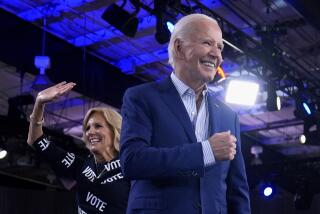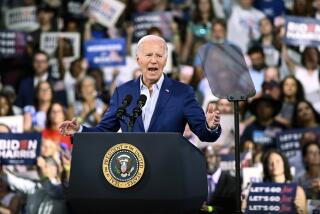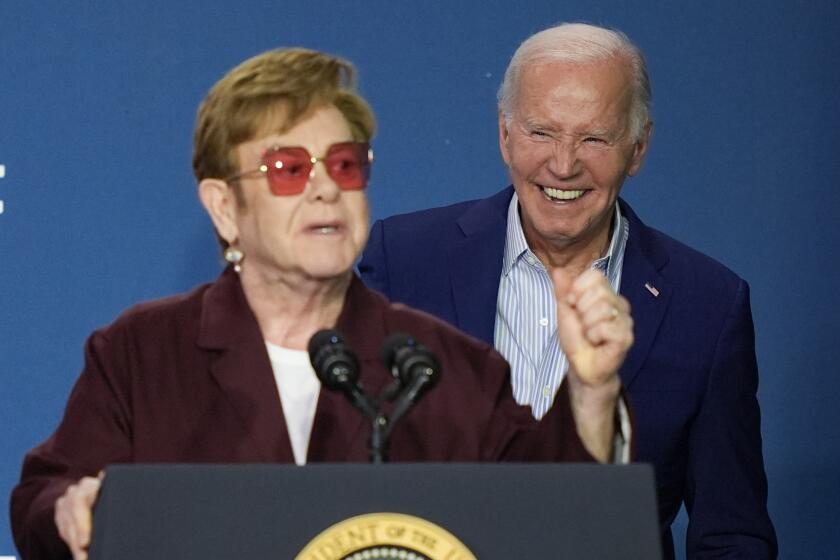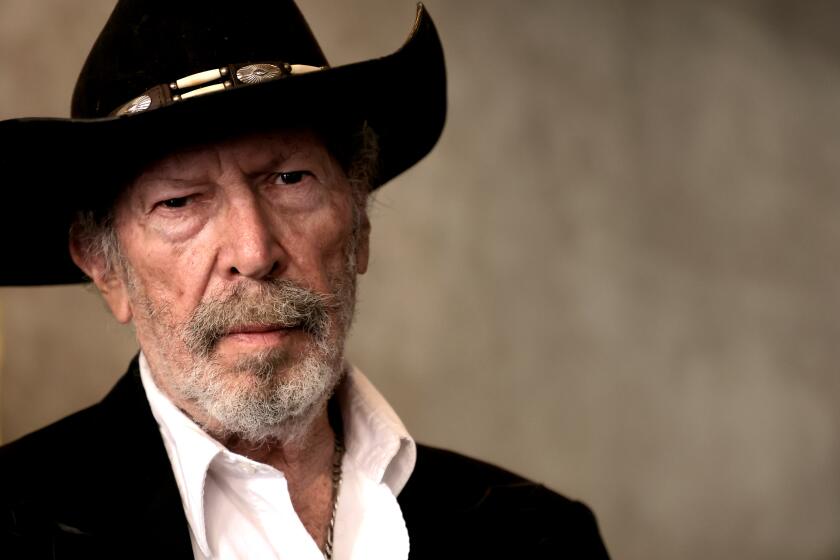Election by Ordeal : WHAT IT TAKES: The Way to the White House <i> By Richard Ben Cramer</i> , <i> (Random House: $28; 1,047 pp.) </i>
For years, voters and pundits alike have been conducting a deathwatch on American politics. The symptoms are well known: fewer people voting, more negative commercials, debate squeezed into ever shorter sound bites on the evening news. The only thing more depressing than these trends has been the suffocating sense that they are irreversible.
Well, don’t look now, but the patient is showing signs of life. Voters are suddenly reasserting control over the election process. One sign is the grass-roots rebellion that has helped businessman Ross Perot emerge as the strongest independent presidential candidate since Teddy Roosevelt ran under the banner of the Bull Moose Party 80 years ago. Another is the proliferation of “new media” campaign appearances that put voters directly in contact with candidates--through television and radio call-in shows, town-hall meetings, the use of 800 numbers--without the filter of the mainstream media. During one remarkable three-day period in June alone, Americans directly questioned President Bush on CBS, Democratic nominee Bill Clinton on NBC and Perot on ABC. In lasting ways, the presidential campaign is being re-created before our eyes.
Against this backdrop of rapid change comes journalist Richard Ben Cramer with a 1,047-page account of the men who sought the White House four years ago. Remember them? By now, most Americans couldn’t pick out the also-rans in the 1988 campaign if they were assembled before them in a police line-up. But they’re here, at least half of them: Republican Bob Dole and Democrats Michael S. Dukakis, Gary Hart, Joseph R. Biden Jr. and Dick Gephardt, as well as the winner, George Bush.
On the surface, their triumphs and failures don’t seem particularly relevant to the wrenching changes roiling the system this year; the day-to-day story Cramer tells often feels as though it is ancient history. But the spirit of this vast, knowing and often maddening book is very much in tune with the Zeitgeist of 1992. Like the outpouring of support for Ross Perot, and the waves of people who call the Today Show to ask the candidates questions that have nothing to do with strategy or polls, Cramer’s book is a cry of protest against a system that has served neither the voters nor the candidates particularly well.
At least that’s one of the ways you can describe this book. It’s lots of other things too. Cramer has produced a work that should be put under glass: It’s one of a kind, a hopped-up amalgam of Teddy White, Tom Wolfe and Norman Mailer--day-glo civics. Everything about this book is oversized: its ambition, its scope, its flaws, its energy. Presidential elections are the white whale of American journalism--and in Cramer they have found a manic Melville.
Somehow, in the end, for all its problems--not the least of which are its exhausting length and its omission of some of 1988’s most important players, particularly Jesse Jackson--this book works. It does so not by breathing life into a campaign most Americans would rather forget, but by documenting the humanity of the men who contested it. Cramer has produced both a compelling read and a cautionary tale--a work of great skill, tenacity and above all, empathy.
The book alternates biographies of the six candidates with jazzy, impressionistic behind-the-scenes accounts of their clashes in the 1988 campaign. There’s plenty of inside stuff about the way campaigns really work, and acid portrayals of the pundits, reporters and consultants who cluster around them. Cramer presents all this with verve, but the insider chatter is the least interesting part of the book.
Cramer has peeked behind many closed doors, but he hasn’t found much there that you wouldn’t expect from the other side of the keyhole. In six different campaigns we see the same story: Consultants fight with each other, and urge their candidates to carpet-bomb their opponents with negative ads. Then, when the campaign hits the rocks, they moan to the press about the failure of their man to follow their brilliant advice.
Cramer’s real contribution is capturing the way campaigns feel. Nothing I have ever read has conveyed as convincingly the frenzy of modern presidential politics--the blur of motion, the endless plane flights, the swarms of reporters buzzing around like some biblical plague, and above all the inability of the candidates to find any time to think.
In Cramer’s vision, running for President has been reduced to a grinding triumph of the will: Only those willing to sacrifice everything can hope to claim the prize. He leaves it to a young Democratic operative named Tom Donilon to deliver the book’s message, its distillation of what it takes to succeed in modern presidential politics. Donilon, as quoted by Cramer, wants to make sure Biden understands what’s ahead if he takes the plunge:”You give up everything . . . give up your life. It’s gone. Home, friends, you’re not there. And you’re all alone. Completely alone. Your relationship with your wife, your whole family, is going to suffer. . .You know why? Because you’re going to want this worse than anything, and it’s going to take over.”
Throughout, there are great moments, rendered with a novelist’s eye for detail. Here’s Gary Hart, looking out from a car surrounded by reporters clamoring for more reaction to the allegations of womanizing, and realizing that if he could “he’d have jumped out and beaten them with his bare hands.” Here’s Dick Gephardt--a ferocious campaigner seemingly immune to emotion--weeping against Jesse Jackson’s shoulder when he realizes his dream has run aground.
That immediacy is one of the best things about the book. The other is Cramer’s skill at biography, most vividly displayed in the interwoven stories of Bush and Dole, whom Cramer presents as epic antagonists virtually destined for their collision in 1988. In an evenhanded and yet devastating portrait, Cramer shows the privilege woven into the fabric of Bush’s life--even his buccaneer years in the Texas oil business were bankrolled by the family--and his willingness to repeatedly shift his positions to advance his career.
He is even better in recounting Dole’s upbringing and his agonizing struggle to recover from crippling wounds in World War II. Cramer’s descriptions of Dole’s hometown of Russell, Kans., during the Depression rival Robert Caro’s recreation of Lyndon Johnson’s Hill Country. It’s easier to understand the senator’s barely contained contempt for Bush after reading about Dole lying in a bed he shared with his brother, listening to maggots prescribed by a doctor eating through the other boy’s diseased leg.
For all the anger he carries with him, Dole seems to be the only President in the bunch--a man who has experienced enough suffering to understand how much of it the world dishes out. Bush comes across as a vacuous careerist, a man more passionate about his Christmas-card list than about any principle. None of the Democrats seem big enough for the top job either. Dukakis, in particular, shows himself to be small, self-righteous, shallow--a prig determined to constantly prove himself smarter than everyone around him. Hart has the smarts, but he’s shown as too solipsistic to be a great leader.
All of these portraits are knowing, but they are also very long. The book is much too long: Reading it takes almost as much stamina as running. Did we really need a detailed reconstruction of the de servedly obscure one-on-one debate between Gephardt and Dukakis?
Cramer’s high-octane writing style might have benefited from the occasional blue pencil too. For his biographical sections, Cramer finds a restrained eloquence that is both intimate and authoritative. But when writing about contemporary events, he frequently goes over the top: Dukakis doesn’t skip out on a meeting with arms-control experts; he dodges “the major-league multiple-reentry-first-strike-throw-weight muckamucks.”
At times, the voice creates a more serious problem. Often it’s not clear whose thoughts we are hearing, Cramer’s or his subjects’. Is it Bush or Cramer describing an ambassador as a credit to the Third World? Did someone really sell Dukakis on the name ET for his welfare-reform package by saying “You see, Michael, there’s this movie,” or is that just Cramer cracking wise?
Cramer also has a self-righteous streak that’s distracting; he’s forever taking potshots at other reporters for messing up the story. It doesn’t seem to be enough for him to show he understands what really happened; he also has to prove that no one else did.
That’s an unattractive trait: None of Cramer’s targets in the press had the luxury of four years to ponder how they would describe the events hurtling before them. Still, his criticism, though gratuitous at times, is more than just carping. Cramer is trying to make a larger point: that the press, fixated on strategy and scandal, has ceased to reveal these men as three-dimensional figures defined by more than their inevitable flaws. As the press hounds Biden from the 1988 race over accusations of plagiarism that seem trivial in retrospect, it appears to be Cramer, as much as the senator, who laments: “They didn’t have room to deal with his life.”
The obliteration of the candidates’ private lives that Cramer fretted about in 1988 has, if anything, accelerated this year. That level of exposure provides for a frequently sordid spectacle, but I’m not sure the old system--when the reporters and the insiders kept such stories to themselves--was any better.
In an era in which party identification has become increasingly meaningless, the reality is that voters judge presidential candidates less as the embodiments of an ideological or partisan tradition than as individuals. Should it be left to the journalistic establishment--an institution hardly in high repute--to decide which information the voters should be allowed to consider in making that judgment? Is it up to the press to decide unilaterally, for example, whether Perot’s use of private investigators in business and political disputes is a factor people may want to consider before giving him control of the FBI and IRS?
On this slippery slope, there may no longer be dividing lines between public and private life as sharp as Cramer apparently yearns for. But if presidential elections are going to turn on the public’s estimation of the candidates’ characters--as I believe they will--the responsibility for everyone involved is to find ways to let the candidates emerge as more than caricatures.
That’s what Cramer has done here. By portraying these men so vividly and so memorably illuminating the costs they endure in seeking the White House, Cramer has contributed significantly to the process that is the most hopeful sign of 1992--the attempt, through new means of communication, to bring the candidates back to life. Writing about a campaign that may already seem distant to most Americans, he has left us with a message very relevant to this one: that we cannot assess a man simply through a search for peccadilloes; that the full measure of character is found over a lifetime, not in a single weak moment.
And he has also produced a rollicking good read, that for all its flaws and eccentricities will stand among the definitive accounts of modern American politics.
Book Mark: For an excerpt from “What It Takes,” see the Opinion section, Page 2.
More to Read
Get the L.A. Times Politics newsletter
Deeply reported insights into legislation, politics and policy from Sacramento, Washington and beyond. In your inbox three times per week.
You may occasionally receive promotional content from the Los Angeles Times.






